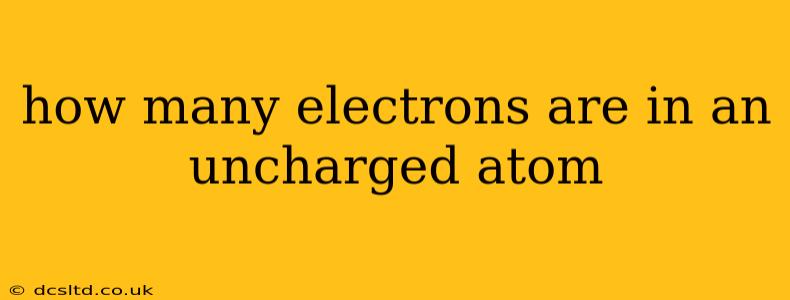The number of electrons in an uncharged atom is always equal to the number of protons in its nucleus. This fundamental principle of atomic structure ensures electrical neutrality. Let's delve deeper into this concept.
What Determines the Number of Electrons?
The key to understanding the number of electrons lies in the atomic number. The atomic number, unique to each element, represents the number of protons found in the atom's nucleus. Since an uncharged (neutral) atom has no net electrical charge, the positive charge of the protons must be exactly balanced by the negative charge of an equal number of electrons.
For example:
- Hydrogen (H): Hydrogen has an atomic number of 1. Therefore, a neutral hydrogen atom contains 1 proton and 1 electron.
- Oxygen (O): Oxygen has an atomic number of 8. A neutral oxygen atom possesses 8 protons and 8 electrons.
- Gold (Au): Gold has an atomic number of 79. A neutral gold atom contains 79 protons and 79 electrons.
What Happens When the Number of Electrons Changes?
When an atom gains or loses electrons, it no longer remains neutral. It becomes an ion:
- Cation: If an atom loses electrons, it becomes positively charged because it now has more protons than electrons. For instance, a sodium atom (Na) can lose one electron to become a sodium ion (Na+), which has a +1 charge.
- Anion: Conversely, if an atom gains electrons, it becomes negatively charged due to having more electrons than protons. A chlorine atom (Cl) can gain one electron to become a chloride ion (Cl-), which has a -1 charge.
How Can I Find the Number of Electrons?
Determining the number of electrons in an uncharged atom is straightforward:
- Identify the element: Know the name or symbol of the element.
- Find the atomic number: Consult a periodic table to find the element's atomic number. This number is usually located above the element's symbol.
- The atomic number is the number of electrons: The atomic number directly tells you the number of electrons in a neutral atom of that element.
What About Isotopes?
Isotopes are atoms of the same element that have the same number of protons but a different number of neutrons. Importantly, the number of electrons in a neutral isotope remains the same as the number of protons, regardless of the neutron count. The difference in neutrons affects the atom's mass but not its charge or electron count.
How are Electrons Arranged?
Electrons are not randomly distributed within the atom. They occupy specific energy levels or shells around the nucleus. These shells have different capacities for electrons. The arrangement of electrons in these shells determines an atom's chemical properties and how it interacts with other atoms.
In summary, the number of electrons in an uncharged atom is precisely equal to its atomic number, a fundamental concept in chemistry and physics. Understanding this relationship is crucial for comprehending the behavior of atoms and the formation of molecules.
